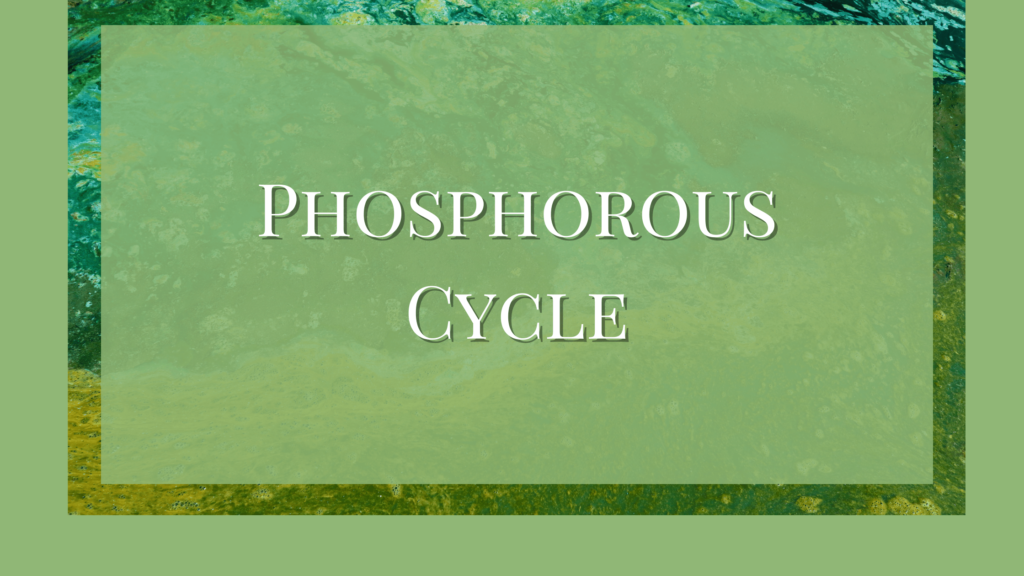Phosphorus is an important element for all organisms. It is a component of the cell membrane, membrane of cell organelles, nucleic acid, and ATP- Adenosine Triphosphate- the major energy molecule. It is a constituent of bones and teeth as well.
Phosphorus Cycle in Ecosystem
There is no atmospheric phase for the phosphorus cycle in ecosystem. The major reservoir of phosphorus is phosphates in rocks and fossil bone deposits that were laid down during the past geological ages.
Use and Release of Phosphorus
Phosphorus becomes available in the soil for plants through natural rock erosion. Due to various activities by humans and otherwise, rocks erode and this erosion releases small quantities of dissolved phosphorus in the form of phosphates into the soil.
From soil, much of these phosphates are washed out into the sea via rivers and floods. Seaweeds take up phosphorus and it will ultimately reach fishes and sea birds. The sea birds deposit their phosphate-rich feces called guano on the land.
Approximately 2 million tonnes of phosphates are mined annually to be used as fertilizer. These fertilizers bring it into the soil. Plants take up phosphorus from soil. Animals get it either directly or indirectly through other animals.
They excrete it mainly as phosphates which the plants can use immediately. Phosphorus is also returned to the soil and water through decay or excreta and dead bodies of organisms.
Locking of Phosphorus
The phosphates may form compounds with metals such as aluminum, iron, or calcium. By this combination phosphates become unavailable to plants and are lost to the cycle. Bones and teeth are resistant to decay and keep their phosphorus contents out of the cycle for a long time.
In the sea, a significant amount of phosphorus is lost in deep sediments. It will become available when geological upheaval brings deep strata to the surface or when man starts deep sea mining to replenish the supplies.
It seems probable that phosphorus is being lost from available sources faster than it is returned. This is because the phosphorus cycle in the ecosystem is a one-way flow from rocks to land ecosystems to the ocean and finally to ocean sediments.
Phosphorus That is Unavailable to Plants
The amount of elemental phosphorus circulating through the phosphorus cycle in ecosystem is much smaller. A major portion of this element remains unavailable to plants and thus to other living organisms as well. The unavailable form includes the phosphorus present in the rocks and sediments. They can be made available through the action of microorganisms such as bacteria through mineralization. However, phosphorus thus made available to plants is only a small portion.
The three forms of unavailable phosphorus in the ecosystem are,
- Several bacteria convert the inorganic phosphorus in the soil and rocks into organic compounds. This phosphorus in organic form is unavailable to plants.
- Phosphorus that is adsorbed or chemically bound to the soil particles is its next unavailable form.
- Soil pH is crucial for the availability of inorganic phosphorus to plants. When the soil pH falls below the required level of 4 or a higher pH of 8, plants will be unable to absorb phosphorus from the soil.
- In addition, frequent crop harvesting leaves no plant debris to decompose and help replenish the nutrients in the soil.
Harmful Side of Phosphorus Cycle in Ecosystem
The excess phosphorus in the soil which remains unused by the plants often runs off during the rainy season and ends up in aquatic ecosystems. It remains in the water unused and leads to eutrophication. Thus it is important to ensure proper usage of this element and to use effluent methods for its applications.
Adding lime and other pH-regulating materials in the soil before fertilization can improve phosphorus absorption by plants. In New Zealand, superphosphate, produced from the rocks using sulfuric acid on insoluble phosphate, is used as fertilizer. This has better absorption by the plants and causes less pollution.
References
- Shukla, R.S. and Chandel, P.S. (2001) Plant Ecology. S. Chand and Company Ltd., New Delhi.
- Verma, P.S., Agarwal, V.K. (1999). Cell biology genetics molecular biology evolution and ecology. New Delhi: S.Chand Co.(Pvt) Ltd.
- The Phosphorus Cycle. (n.d.). Science Learning Hub.




